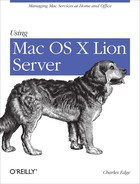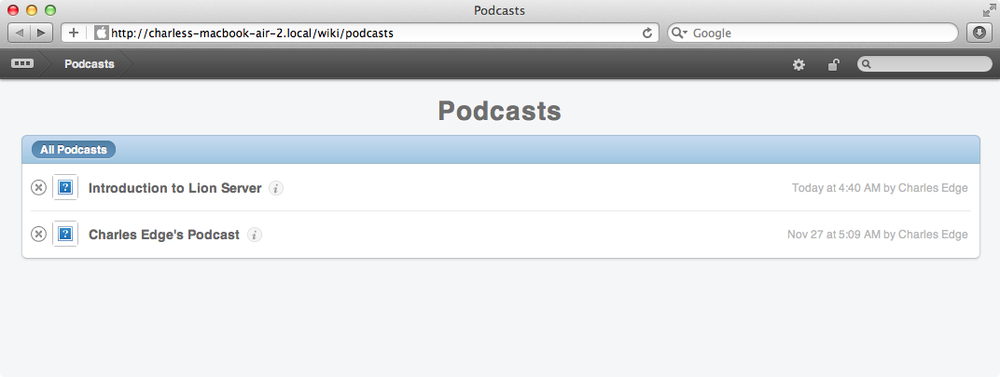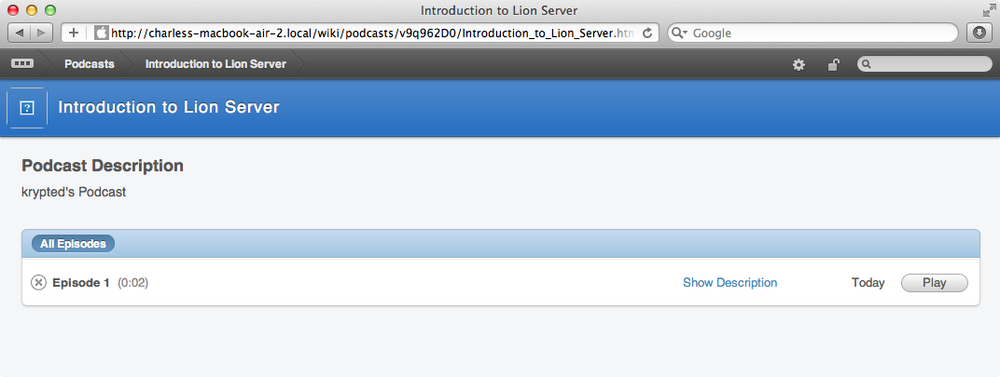Why capture a podcast if no one can view what you’re working on? All published podcasts are kept in the Podcast Library. This library is viewed from the built-in web portal installed with Lion Server when you enable the web service.
To access a podcast episode, open the default web portal installed in Lion Server. Then, click on the Podcasts icon.
At the Podcasts window, you will see all of the podcasts that you have access to (Figure 7-7). Each user will, by default, own podcasts they create. If the permissions for new podcasts was set to Podcast Owners, then other users will, by default, not see each others podcasts. If you uploaded podcasts but do not see any, click on the lock icon, and when prompted, authenticate with the same credentials used to create your first podcast.
Click on the name of the podcast to access the podcast’s screen, shown in Figure 7-8. Here, you can see each episode of the podcast (previously you would have seen them on the corkboard). Click on the Play button to view each episode of the podcast.
Podcasts are displayed using a QuickLook screen. Here, click on the X or press the Escape key to close each podcast’s screen.
At any point, you can change the permissions for each podcast. This means you can set podcasts (not episodes of podcasts, but podcasts themselves) up in such a way that only specific users and/or groups can access content.
To limit who can access a podcast, browse to a specific podcast and then click on the cogwheel icon in the grey bar at the top of the screen. Click on Settings to bring up the permissions screen, shown in Figure 7-9. In the box below the field “The following people and groups can access this podcast,” enter the short name of a user or group who you would like to allow access to a podcast. Users and groups that match the search string you enter will appear. Click on the appropriate entry and the user or group is listed in the list below the field. Here, click on the drop-down list of permissions options to set what kind of access the user or group has to the podcast.
Each user can have “Read only” or “Read & write access.” If a user is not listed, then they are inherently not able to access the podcast. Users and groups with “Read only” can watch podcasts while users and groups with “Read & write” can edit the podcast using the Podcast Publisher utility described earlier in this chapter.
Once all of the users and groups you want to access a podcast are appropriately configured, click on the Save button and then test viewing a podcast while logged in as a user who was just configured (or a user who resides in the appropriate group).
Content is accessible through a web interface. But using that web interface, you cannot watch content when not online. iTunes is Apple’s default media player, available on Windows and Mac OS X. Given the popularity of the client, Apple uses it as an aggregator for Podcast Producer-based content. This is known as subscribing to a podcast. When subscribed to a podcast from Podcast Producer, iTunes downloads and caches each podcast that is published automatically. Podcasts can then be viewed from an airplane, on the road, or using fleets of laptops in class, with little fuss.
To subscribe to a podcast using iTunes, first open a podcast. Then, click on the cogwheel icon and click on Subscribe in iTunes….
iTunes then opens and shows the podcast caching (Figure 7-10). Accessing podcasts from then on out involves simply opening iTunes and clicking on the Podcasts icon in the iTunes sidebar. From here, all podcasts that are downloaded will be shown.
Note
Blue dots beside the name of a podcast episode indicate whether or not an episode has been watched. This allows viewers to quickly discern which episodes they have seen versus which episodes they haven’t.
When we are setting up servers for the first time, we often test features. It is easy to imagine that the first few tries at podcasting will result in limited success. Therefore, to delete a podcast, simply control-click (or right-click if you have two buttons on your mouse) on the name of a podcast and click on Delete to remove the podcast from within iTunes.




